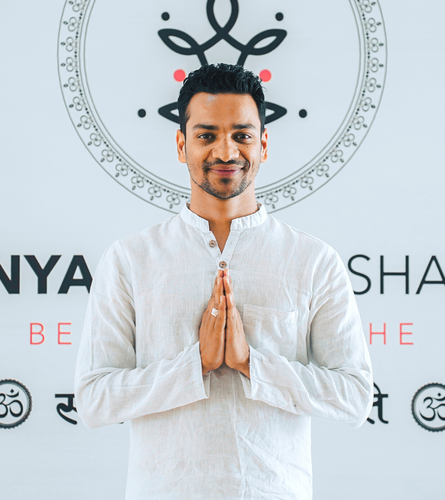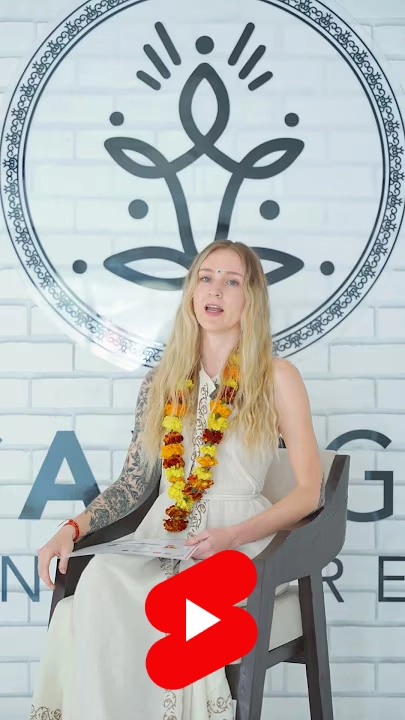Mantra & Mantra Chanting
Mantra
Mantras are sacred sounds, words, or phrases which are recited to
attain spiritual attention. In other words, a mantra is a tool of
the mind. It helps the mind in focusing better.
- Art of Mantra
- Science of Mantra
- Power of Mantra
- Formation of Mantra
- Mantra as a Religion
- Vibration of Sound
Mantra Chanting
Mantra Chanting is a powerful tool which develops a spiritual
connection inside you. It, in turn, creates a balance between the
body, mind, and spirit.
- How to chant the mantra properly?
- Om Mantra
- Peaceful Shiva Mantra
- Energetic Durga Mantra
- Kundalini Mantra
- Ganesha Mantra for removing hurdles
- Joyous Krishna Mantra
- Gayatri Mantra for the purification of the mind
- Sahana Mantra for Guru Disciple Study
- Guru Mantra for paying homage to Guru
-
Early Morning Chant - asato ma sadgamaya, tamaso ma
jyotirgamaya, mrtyorma amrtam gamaya, om shanti shanti shanti ||
-
Surrender Mantra - twameva mata cha pita twameva, tvameva
bandhushcha sakha tvameva, tvameva vidya dravinam tvameva,
tvameva sarvam mama deva deva ||
-
Maha Mritunjaya Mantra - Om Tryambak Yajamahe, Sugandhim
Pushtee-Vardhanam, Urvarukmeva Bandhanaan, Mrtyoh-Mrukshiya
MaaMmrataat
- Patanjali Mantra (Yogenacittasya)
-
Suryanamaskar 12 Mantra - Om Mitraaya Namaha, Om Ravaye Namaha,
Om Suryaaya Namaha, Om Bhaanave Namaha, Om Khagaya Namaha, Om
Pooshne Namaha, Om Hiranyagarbhaaya Namaha, Om Mareechaye
Namaha, Om Adityaaya Namaha, Om Savitre Namaha, Om Aarkaaya
Namaha, Om Bhaskaraaya Namaha
Traditional Hatha Yoga
Traditional Hatha Yoga sessions conducted by our school are a
positive workout for one's physical and mental wellness. It
originated years ago with the aim to attain health and peace. The
practice also benefits you with strength and flexibility.
- PavanMuktasana series 1 (15 practices)
- PavanMuktasana series 2 (10 practices)
- PavanMuktasana series 3 (10 practices)
-
Centering postures series (Yoga Sequence Builder) (5 practices)
- Surya Namaskar (Sun Salutation) (12 asana series)
- Chandra Namaskar (Moon Salutation) (12 Asana Series)
- Standing postures series (10 practices)
- Kneeling postures series (5 practices)
- Sitting Postures series (10 practices)
- Forward bending postures series (5 practices)
- Backward bending postures series (5 practices)
- Supine postures series (6 practices)
- Prone Postures series (5 practices)
- Fire Series series (5 practices)
- Inversions series (5 practices)
- Twisting postures series (5 practices)
- Balancing Postures series (5 practices)
- Relaxing Posture series (5 practices)
- Meditative Asana Series (5 practices)
Overall you will learn 140 series of asanas.
Theory of Hatha Yoga
You have done practice sessions but what about theory? It is also
as important as practice sessions. If you are not theoretically
aware of Hatha yoga and its elements, you are not able to practice
it well.
- Hatha Yoga Philosophy
- Ancient Scriptures & Texts of Hatha Yoga
- Aim and Objectives
- Yoga as a Therapy
- Yoga as Balancing
-
Connection of Hatha Yoga with Chakras, Nadis, Kundalini, and the
Subtle Body
Ashtanga Yoga
More than a teaching session conducted by yog gurus, Ashtanga Yoga
is a self-assisted and practice class. All students are doing the
same sequence and postures, supported by experienced teachers.
- Introduction
- History
- Awakening the Inner Fire
- The Breath of Life (Prana)
- Chakras
- Eight Limbs of Yoga (Ashtanga Yoga)
- The practice of K.Pattabhi Jois
- Bandha practice
- Drishti (Focusing the Attention)
- Cleansing & Purification
- Developing a pious platform for yogic practice
- Use of yoga props and instruments
-
Sun Salutation A & B (week 1) - Surya Namaskar Series A
& B
- Standing Asana Series (week 2)
- Sitting Asana Series (Week 3)
- Finishing Asana Series (Week 3)
-
Teaching Practices (Traditional & Mysore Style- Week 4)
- Padangustasana (Big toes Posture)
- Pada hastasana (Hand under foot posture)
- Utthita trikoṇasana (A+B) (Triangle posture)
- Utthita parsvakonasana (A+B) (Extended side angle pose)
-
Prasarita padottanasana (A,B,C,D) (Intense wide leg stretch)
- Parsvottanasana (Intense side stretch posture)
- Utthita Trikoṇasana (A+B) Triangle posture
- Utthita Parsvakonasana (A+B) Extended side angle pose
-
Prasarita Padottanasana (A,B,C,D) - Intense wide leg stretch
- Parsvottanasana – Intense side stretch posture
- Utthita Hasta Padangusṭasana- hand to big toe posture
-
Ardha bandha padmottanasana (Half-bound lotus forward bend)
- Utkatasana (Fierce pose)
- Virabhadrasana (Warrier pose) A+B
- Dandasana (Staff pose)
-
Pascimattanasana (Intense west stretch or sitting forward bend)
- Purvattanasana (Intense east stretch)
-
Ardha bandha padma pascimattanasana (Half bound lotus forward
bend)
-
Tiryangmukha Eka pada pascimattanasana (Reverse the leg, one leg
intense stretch)
- Janusirsasana (Head-to-knee pose)
- Marichyasana (Leg Binding Pose)
- Navasana (Boat Pose)
- Bhujapiḍasana (Shoulder Pressure Pose)
- Kurmasana (Tortoise Pose)
- Suptakurmasana (Reclining Turtle Pose Yoga)
- Garbhapindasana (Womb Pose)
- Kukkutasana (Cockerel Pose, or Rooster Posture)
- Baddha Konasana (Bound Angle Pose, Butterfly Pos
- Upavistha Konasana (Seated Angle Posture)
- Suptakonasana
- Supta Padangustasna
- Ubhaya Padangustasna
- Urdhvamukha Pascimattanasana
- Setubandhasana (Bridge Pose)
Finishing Postures
- Urdhva Dhanurasana (upward bow posture)
- Salaṁba sarvangasana (shoulder stand posture)
- Halasana (plough posture)
- Karṇa pidasana (ear pressure posture)
- Pindasana (Embryo Pose)
- Matsyasana (Fish Pose)
- Uttanapadasana (Leg Lifting Posture)
- Chakrasana (Wheel Pose)
- Shirshasana (Yoga Headstand)
- Baddhapadmāsana (Bound Lotus Posture)
- Yoga Mudra
- Padmasana (Lotus Pose)
- Utpluthiḥ
- Savasana (Corpse Pose)
Pranayama (Breathing Practices)
Prana, the life energy Yama means control. It is the foundation
practice of traditional form of yoga. It is not just a breathing
practice but much more than this. The class of pranayama reveals
its secrets and the power of pranayama to gain the right health,
peace, and balance.
The four week course offers a different experience, such as,
Week 1: Step wise knowledge of pranayama and
building strength.
Week 2: From the beginning to the deep core of
pranayama.
Week 3: Advance practice by holding the breath
and manifesting chakra awareness.
Week 4: Teaching practice while moving to the
master level of the breath.
Pranayama Topics:
- Definition of Prana
- Definition of Pranayama
- Definition of breath
- Connection of the Prana and the breath
- Importance of Pranayama
- Benefits of Pranayama
- Preparing ourselves to practice pranayama
- Aspects of Breathing
- Ancient Texts of Breathing
- General understanding
- Knowledge of nostrils
- Activating nostrils for pranayama
- Secrets of Pranayama
- Breath flow in 5 elements
- Unit of Prana
- Function of Prana
- Three levels of Prana
- Three Gunas
- Flow of Prana
- Quality of breath
- Imbalance of Prana
- Retention of breath
- 6 Sitting postures for Pranayama practices
- Breathing pattern
- Chakras and Kundalini connect with Prana
Beginners and Intermediate Practices of Pranayama
- Clavicular Pranayama
- Thoracic Pranayama
- Diaphragmatic Pranayama
- Yogic Pranayama
- Pranava Pranayama (Om Meditation Breathing)
- Nadi Shodhana Pranayama or Anulom Vilom Pranayama
- Bhastrika Pranayama (Bellows Breath)
- Kapalbhati Pranayama (Skull Shining Breath)
- Bhramari Pranayama (Humming Bee Breath)
- Ujjayi Pranayama (Ocean Breath)
- Sitali Pranayama (Cooling Breath)
- Sitkari Pranayama (Hissing Breath)
- Murcha Pranayama (Swooning Breath Yoga)
- Surya Bhedi Pranayama (Right Nostril Breathing)
- Chandra Bhedi Pranayama (Left Nostril Breathing)
Meditation (Dhyana)
Just like you involve your body in physical exercise for its
benefits, in the same way, meditation is an exercise for mental
health. With the power of meditation, you can control your mind
and block negative and unnecessary thoughts. You enter into a deep
state of relaxation where peace is the ultimate goal.
During the meditation class, you are advised to sit quietly by
keeping your focus on a single thing. It helps you in eliminating
tension and stress. With the 200 Hours yoga teacher training
course, you get to learn basic and intermediate techniques of
meditation. The four weeks program work as,
Week 1: Introducing Meditation and Building
Foundation
Week 2: Making the mind able to focus on a single
aspect with concentration process and exercises.
Week 3: Meditation Techniques
Week 4: Chakra Awareness and Kundalini Meditation
What'll you learn?
- What is Meditation?
- History and Origin of Meditation
- How to prepare yourself for Meditation?
- What Meditation is actually?
- What Meditation is not?
- Why to meditate?
- How to meditate?
- Where to meditate?
- When to meditate?
- Philosophy of Meditation
- Meditation Traditions
- Meditation Scriptures
- Aim and Objectives of Meditation
- Sitting Positions
- How to Sit Correctly
- Preliminary Practices Before Practicing Meditation
- Diaphragmatic Breathing in Meditation
- Correct Breathing in Meditation
- How to Relax in Meditation?
- Lifestyle in Meditation
- Diet of Meditation
- Why should one sleep while meditating?
- What are the rules of meditation?
Styles of Meditation Practices
Himalayan Meditation Practices
- Basics Foundation Meditation Practice
- Breath- Mind- Mantra Awareness
- Trataka Meditation
Nada Meditation Practices
- Music Meditation
- Om Meditation
- Mantra Power Meditation
Active Meditation Practices
- Dynamic Moving Meditation (Osho)
- Buddha Walking Meditation
- Karma Yoga Meditation
- Natraj Meditation
- Sufi Meditation
- Gaurishankar Meditation
- Ajna Chakra Awakening Meditation
- Kundalini Active Meditation
Vipassana & Passive Meditation Practices
- Breath Awareness (Anapana)
- Mindfulness and Sensation
- Total Awareness Practice
- How to Do Japa (recitation)
Kirtan Even and Creating a Spiritual Vibe
One-Day Silence Meditation
Silence Practice
Yoga Nidra (Psychic Sleep)
Yoga Nidra is also known as Psychic Sleep. The practice creates a
state between waking and sleeping. It is a state of consciousness.
One can go into this deep and conscious sleep with the practice of
guided meditation. Yoga Nidra can also be termed as the victory
over sleep. You can relax your mind and complete the sleep of 8
hours in just a short practice of yoga nidra. When you go through
the epic, Mahabharata, you get to know that Arjuna (one of the
Pandavas) was associated with Yoga Nidra.
The four-week program of Yoga Nidra includes,
Week 1: Basic Relaxation Practices
Week 2: Visualisation Yoga Nidra
Week 3: Chakra Awareness Yoga Nidra
Week 4: Inner Flame Yoga Nidra
What'll you learn?
- Basics of Yoga Nidra
- Meaning of Yoga Nidra
- Purpose of Yoga Nidra
- Different Schools of Yoga Nidra
- Traditions of Yoga Nidra
- Tantric Origin of Yoga Nidra
- Lifestyle for Yoga Nidra Practitioners
- Rules for Yoga Nidra Practitioners
- Benefits of Yoga Nidra
- Risks of Yoga Nidra
- Difference Between Yoga Nidra and Meditation
- Yoga Nidra Experience
- Yoga Nidra and Healing
- 4 States of Consciousness
- 3 Body Awareness
- Tension Relaxation
Yoga Cleansing (Shatkarma)
"Shat" means "Six" and "Karma" means "Actions". Thus, as per yogic
science, Shatkarma is six cleansing actions that help to clean
your body and mind. It is well described in the Hatha Yoga
Tradition. Shatkarma is an important practice to maintain a
balance between body and mind and also promote well-being. The
practice eliminates toxins from the body and unblocks energy
channels.
With the 200 Hours Yoga TTC, you will learn,
- Introduction to Shatkarma
- Benefits of Shatkarma
- Risks of Shatkarma
- Who should practice it?
- Who should not practice it?
- Experiences
- Preparation to Shatkarma
- Practices After Completing It
- Cleansing of Nadis or Energy Channels
Practices that you will learn
- Jihwa Dhauti (Tongue Cleansing)
- Danta Dhauti (Teeth Cleansing)
- Karna Dhauti (Ear Cleansing)
- Jalaneti (Cleansing with Water)
- Kapalbhati (Mind Cleansing)
- Agnisara (Cleansing with Fire)
Yoga Philosophy (Yoga Darshana)
Yoga Philosophy is a powerful subject that can change one's life.
Many are confused that it only exists in Patanjali's Yoga Sutras
but this is not true. It is the philosophy of life which can also
be found in Bhagwat Geeta, Hatha Yoga Pradipika and Upanishads.
The basic and main philosophy of yoga is simple, body, mind, and
soul are one and one can not separate them.
During the 4 weeks of the 200 Hours Yoga Course, Yoga Philosophy
will explain to you the motive of life.
Week 1: The World of Wisdom
- Introduction to Indian Culture
- Spirituality and Himalayan Tradition
-
Introduction to the Ancient Scriptures of Yoga and Spirituality
- Meaning of Indian Philosophy
- Purpose of Indian Philosophy
- Introduction to 9 Major Indian Philosophy
- What is Yoga Philosophy the Most Important among All?
- History of Yoga
- Types of Yoga
Week 2: Yoga Sutras of Patanjali
- Patanjali and His Work
- Introduction to Yoga Sutras Text
-
Eight Limbs of Yoga (Ahimsa, Satya, Asteya, Brahmacharya,
Aparigraha, Saucha, Santosha, and Tapas)
- Yamas & Niyamas
- Philosophy of Asana & Pranayama
- Karmic Science
Week 3: Internal Limbs
- Concentration, Meditation, and Samadhi
- First Chapter
- Second Chapter
- Third and Fourth Chapters of Patanjali
- Mind and Its Control
- Introduction to Bhagavat Geeta & Upanishad
Week 4: Exploring the wisdom of Yoga
- Chakras
- Nadi
- Kundalini
- Three Fold Pain
- Three Bodies (Sharira)
- Pancha kosha
- Tri-guna
- Mahabhuta (Theory of Elements)
Anatomy & Physiology (Sharir Vijnan)
In yoga, anatomy is a crucial subject for yoga teachers and
learners. In the class, you will get to know physical anatomy and
spiritual anatomy.
Physical Anatomy
- Introduction to Body
- Bodily Structures
- Body Planes
- Anatomical Movements
- Bones of the Skull
- Cervical Vertebrae
- Shoulder Girdle/ Arm Bones/ Pelvic Region
- Deformities of the Spine
- Lower Extremity
- Tendons and Ligaments
- Muscular System
- Nervous System
- Respiratory System
Spiritual Anatomy
- Nadi (Energy Channel)
- Chakras (Energy Centres)
- Kundalini (Prime Energy and Souce of All Creativity)
- Pancha kosha (5 Layers)
- Pancha Mahabhuta (5 Elements and Body Structure)
- Tri-Guna (Three Attributes)
Yoga Therapy
Yoga is the wellness science for nurturing the body, mind and
spirit. It is the natural healing process to keep you healthy and
free from illness. Yoga therapy uses yoga postures, breathing
exercises (pranayama), meditation, and other practices to improve
physical and mental well-being. Yoga therapy encourages the
amalgamation of the body, mind, and spirit.
In the 200 Hours Yoga Course, you will learn,
- Definition of Yoga Therapy
- Rules and Regulations of Yoga Therapy
- Healing Through Asana, Pranayama and Meditation
- Therapy for Common Diseases
Ayurveda
Ayurveda is the oldest and the most natural system of medicine
that originated in India years ago. It is approximately 3000 years
ago medicinal science. Ayurveda is derived from two words, "Ayur"
means "Life" and "Veda" means "Science", thus Ayurveda describes
the meaning "Science of Life" or 'Knowledge of Life'. As per
Ayurvedic Science, the body is made up of five elements, i.e.
Akash (Ether), Vayu (Air), Agni (Fire), Apas (Water), and Prithvi
(Earth). These 5 elements create 3 doshas namely, Kapha, Vata and
Pitta. When these are balanced, then an individual remains healthy
and when these are imbalances, an individual remains ill. Ayurveda
helps in balancing all of these to give you a healthy lifestyle.
The 200 Hours Yoga Course explains,
- What is Ayurveda?
- Ayurvedic Treatment and its Unique Features
- Ayurveda and Its Diversified Areas
- Ashtanga Ayurveda
- Fundamentals of Ayurveda
-
Panchamahabhuta [Earth (Prithvi), Water (Jal), Fire (Agni), Air
(Vayu) and Aether / Space (Aakash)]
- Kapha
- Vata
- Pitta
- Prakriti- Know Your Constitution
Mudras
Mudra is a symbolic gesture. It is normally practices with hands
and fingers, explaining the flow of energy in the subtle body. It
brings a wondrous change in body and mind.
The 200 Hours Yoga Course explains,
- Mudras
- The Secrets of Mudra
- The Position of Elements in the Hands
- The Need for Mudra
- Advantages of Mudras
- Special Guidelines About Mudra
- Gyan Mudra (Gesture of Wisdom)
- Purn Gyan Mudra (Gesture of Complete Wisdom)
- Vairagya Mudra (Gesture of Dispassion)
- Abhaya Mudra (Gesture of Fearlessness)
- Dhyana Mudra (Meditation Mudra)
- Vayu Mudra (Gesture of Air)
- Pran Mudra (Gesture of Prana)
- Prithvi Mudra (Gesture of Earth)
- Surya Mudra (Gesture of Sun)
- Varun Mudra (Gesture of God of Water)
- Shoonya mudra (Gesture of Openness, Space)
- Pran-Apan Mudra (Gesture of Prana Apana)
Bandhas (Energy Lock)
Bandhas is the Sanskrit word which means Lock. The aim of it is to
block the energy flow from a particular part of the body. When the
lock is opened, then the energy flows properly throughout the body
and maintains overall wellness and vitality.
- Meaning and Importance of Energy Lock
- Why the Energy Lock and How Our Energy Gets Drained
- Energy Knots and How to Open Them
-
Understanding the Three Chakras (Muladhara, Manipura, Visuddhi)
- Experience with Energy Lock
- Benefits and Risks of Bandha Practices
Practices (Beginners and Intermediate Level)
- Agnisar (Preparation to Uddiyana)
- Vahir Kumbhaka (External Retention)
- Antar Kumbhaka (Internal Rentention)
- Ashwini Mudra to prepare Mulabandha
- Vajroli Mudra to prepare Mulabandha
- Mula bandhas (Root lock)
- Uddiyana bandha (Abdominal lock)
- Jalandhar Bandha (Throat Lock)
Teaching Methodology
While being a student, it is also necessary to learn to teach. You
are on a journey from being a student to a teacher.
- Proper sequence
- Avoid injuries
- Happiness during and after the practice
- Work with various styles of yoga and in all levels
- Meditative experience
- Managing the energy flow
- Balancing the energy flow
What you'll learn?
- Proper demonstration of a Yoga practice
- The proper way to instruct and guide a lesson
- Proper alignment of yoga postures
- Proper adjustment with/ without props
- Yogic personality establishment
Alignment
In yoga, alignment is the right way to perform any asana so that
one can minimise the risk of injury and reap maximum benefits from
it.
What'll you learn?
- Sense of alignment
- Role of alignment in daily practice
- Balancing prana & chakras
- Alignment and 5 koshas
- Importance of Alignment
- A different aspect of Alignment
- Minimising the risk of injuries
- Increase the movement of joints
- Alignment based on body regions
- Upper Limb alignment
- Lower Limb alignment
- Torso – Thorax - Abdomen – Pelvis Alignment
- Alignment of Head & Neck
- Alignment of the spine
- Basic postures of alignment
- Bringing the body into comfortable zone
- Balancing the body and mind
Adjustment
Adjustment in yoga is also about learning the correct technique of
yoga.
You'll learn,
- What is yoga adjustment?
- Sense of yoga adjustment
- Level of yoga adjustment
- Why adjustment is needed in yoga asana
- Role of adjustments in yoga asana class
- The right technique for perfect adjustment
- Bandhas
- Dynamics of each asana
- How to adjust self adjust in a posture
- How to adjust to others during the class
- Methods of Adjustment
- Tools and props to achieve the peak in the posture
- Body weight management
- Safety rules
- Preparations for adjustment
Yoga For Health
- Yogic counselling for a healthy life.
- Yogic techniques to use in daily lifestyle.
-
Yoga cures common diseases like Headaches, migraine, colds,
sinus, etc.
-
Yoga tools for back issues like backache, slipped disk,
sciatica, diabetes, thyroid, spinal deformities, obesity, etc.
Evaluation & Certification
- Performance during the course
- Attendance
- Practical asana demonstration test
- Written test (Objective and subjective type)
- Behavior


























































































































































































































 Enroll Now
Enroll Now